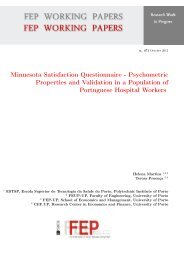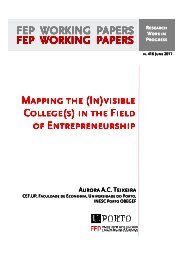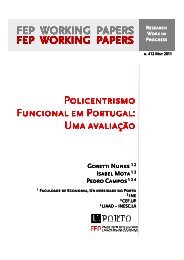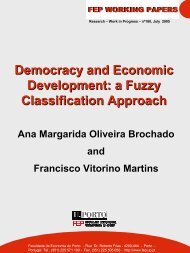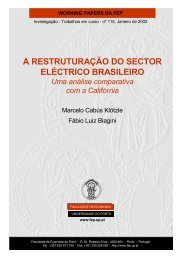FEP - Working Papers - Universidade do Porto
FEP - Working Papers - Universidade do Porto
FEP - Working Papers - Universidade do Porto
You also want an ePaper? Increase the reach of your titles
YUMPU automatically turns print PDFs into web optimized ePapers that Google loves.
In (the candidate) equilibrium, p∗ iR , we have PR − PL = n−1t.<br />
As a result,<br />
n+2<br />
�<br />
j∈I\{i}<br />
(pjR − pjL) + 3<br />
n + 2 t − piL =<br />
n − 1<br />
n + 2 t ⇔ sL =<br />
n − 4<br />
n + 2 t + sR + piL. (12)<br />
As the value of sL <strong>do</strong>es not depend on piR, it has the same value in D2 and in D3. Then,<br />
substituting (12) in (11), we find that p ∗∗<br />
iR is outside D2 when:<br />
sR<br />
2<br />
Then, if sR + piL ≥ √ 18t,<br />
p∗∗<br />
n+2 iR<br />
piL<br />
+<br />
2 ≥ −t + 2sR<br />
n − 4<br />
+ 2piL +<br />
n + 2 t ⇔ sR + piL ≤ 4<br />
n + 2 t.<br />
= sR<br />
2<br />
equilibrium, p ∗ iR . We conclude that p∗ iR<br />
+ piL<br />
2 is in D2 and, therefore, upsets our candidate<br />
∀i ∈ I, sR + piL ≤<br />
is an equilibrium if and only if:<br />
√ 18<br />
n + 2 t.<br />
An equivalent, but more elegant, condition is obtained by using (12):<br />
�<br />
� �<br />
�<br />
�piL − 3<br />
n + 2 t<br />
�<br />
�<br />
�<br />
� ≤ n + 6√2 − 7<br />
t < t.<br />
n + 2<br />
i∈I<br />
The equilibrium demand and profits follow immediately. �<br />
Proof of Proposition 2.<br />
By Lemma 1, the best response prices are such that � n<br />
i=1 |piL − piR| ≤ t.<br />
The first-order conditions for the profit-maximization problems of the department stores<br />
imply that:<br />
yielding:<br />
PL = PR<br />
2<br />
t<br />
+<br />
2 and PR = PL t<br />
+<br />
2 2 ,<br />
PL = PR = t.<br />
The equilibrium demand and profits follow immediately. �<br />
Proof of Lemma 2.<br />
25



